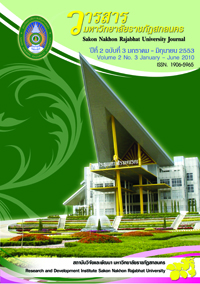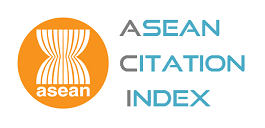การพัฒนาหลักสูตรท้องถิ่นเรื่อง ศิลปกรรม วัฒนธรรม ประเพณี บ้านท่าแร่ สำหรับนักเรียนชั้นประถมศึกษาปีที่ 6
Abstract
บทคัดย่อ
การศึกษาครั้งนี้เป็นการวิจัยและพัฒนา มีจุดมุ่งหมายเพื่อพัฒนาหลักสูตรและศึกษาผลการใช้ หลักสูตรท้องถิ่นเรื่อง ศิลปกรรม วัฒนธรรม ประเพณีบ้านท่าแร่ สำหรับนักเรียนชั้นประถมศึกษาปีที่ 6 โดย มีวิธีการวิจัย แบ่งออกเป็น 4 ขั้นตอนคือ การศึกษาข้อมูลพื้นฐาน การสร้างหลักสูตรการทดลองใช้หลักสูตร การประเมินผลและการปรับปรุงหลักสูตร
ขั้นการนำหลักสูตรไปทดลองใช้กับกลุ่มตัวอย่าง แบ่งเป็น 2 ระยะ คือ การศึกษานำร่องและการ ทดลองใช้หลักสูตร การศึกษานำร่องเป็นการนำหลักสูตรไปทดลองใช้กับนักเรียนชั้นประถมศึกษาปีที่ 6/1 โรงเรียนเซนต์โยเซฟท่าแร่ ตำบลท่าแร่ อำเภอเมือง จังหวัดสกลนคร จำนวน 30 คน เพื่อศึกษาความเหมาะสม ของการใช้หลักสูตรในสภาพจริง พบว่า ความเหมาะสมของการใช้หลักสูตรอยู่ในระดับมาก หลังจากนั้นนำ หลักสูตรไปทดลองใช้กับกลุ่มตัวอย่างที่เป็นนักเรียนชั้นประถมศึกษาปีที่ 6/2 โรงเรียนท่าแร่วิทยา ตำบลท่าแร่ อำเภอเมือง จังหวัดสกลนคร จำนวน 30 คน ใช้ระยะเวลาทดลอง 12 วันๆละ 2 ชั่วโมง รวม 24 ชั่วโมง รวม เวลาทดสอบก่อนและหลังการทดลองใช้หลักสูตรด้วย ใช้รูปแบบการทดลองแบบกลุ่มเดียวทำการทดสอบก่อน และหลังการทดลองใช้หลักสูตร ผลการวิเคราะห์ข้อมูล พบว่า 1) หลักสูตรท้องถิ่นเรื่อง ศิลปกรรม วัฒนธรรม ประเพณีบ้านท่าแร่ มีประสิทธิภาพ 87.13 /88.17 สูงกว่าเกณฑ์มาตรฐาน 80/80 ที่ได้กำหนดไว้ 2) ผลสัมฤทธิ์ ทางการเรียนหลังการทดลองใช้หลักสูตรท้องถิ่นสูงกว่าก่อนทดลองใช้หลักสูตรท้องถิ่นอย่างมีนัยสำคัญทาง สถิติที่ระดับ .01 3) คะแนนเฉลี่ยผลการเรียนรู้ด้านเจตคติ เท่ากับ 4.18 อยู่ในระดับมาก สูงกว่าเกณฑ์ที่กำหนด (3.50) 4) ค่าเฉลี่ย ความเหมาะสมของการใช้หลักสูตรท้องถิ่นเรื่อง ศิลปกรรม วัฒนธรรม ประเพณีบ้านท่าแร่ ประเมินโดยนักเรียนเท่ากับ 4.52 อยู่ในระดับมากที่สุด สูงกว่าเกณฑ์ที่กำหนด (3.50) อย่างมีนัยสำคัญทางสถิติ ที่ระดับ .01 แสดงว่า หลักสูตรที่พัฒนาขึ้นมีประสิทธิภาพตามเกณฑ์ และสามารถนำไปใช้จัดการเรียนรู้ได้อย่าง มีประสิทธิภาพ
Abstract
This study was research and development with an objective to develop and to study the results of using the local curriculum on works of art, cultures and traditions of Ban Tharae for Prathom Suksa 6 students. The research methodology consisted of four stages: a study of fundamental data,curriculum design, experimentation, evaluation and improvement.
The experimentation of the curriculum was divided into two periods : pilot study and curriculum experiment. In the pilot study the curriculum was used with 30 Prathom Suksa 6/1 students at St. Joseph School, Tambon Tharae, Amphur Mueang, Sakon Nakhon to study the suitability of using the curriculum in a real situation. It was found that the suitability of the curriculum was at a high level. After that the curriculum was experimented with 30 samples who were in Prathom Suksa 6/2 students at Tharaewittaya School, Tambon Tharae, Amphur Mueang, Sakon Nakhon. The experiment took two hours daily for 12 days. This included a pretest before using the curriculum and a posttest after using the curriculum given to the same group of students. The of study were as follows : 1) The local curriculum on works of art, cultures and traditions of Ban Tharae had efficiency of 87.13 / 88.17, which was higher than the established of 80/80 2) The learning achievement after using the curriculum was higher than the learning achievement before using the curriculum at .01 level of significance. 3)The average score of the expected attitudinal outcome was 4.18, which was at a high level, higher than the set criteria (3.50). 4) The average suitability evaluation of the local curriculum on works of art, cultures and traditions of Ban Tharae for Prathom Suksa 6 students was 4.52, which was at the highest level, higher than the set criteria (3.50) at .01 level of significance. All these values showed that the developed curriculum is efficient according to the criteria in curricular efficiency evaluation and can be used in managing learning efficiently.








